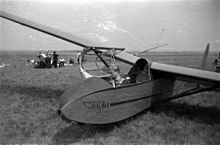PZL Bielsko SZD-10
| SZD-10 Czapla | |
|---|---|
 SZD-10 bis in the Polish Aviation Museum |
|
| Type: | Glider |
| Design country: | |
| Manufacturer: | |
| First flight: |
November 23, 1953 |
| Production time: |
1953-1960 |
| Number of pieces: |
2 + 134 |
The PZL Bielsko SZD-10 Czapla ( German heron ) is a Polish glider . The abbreviation SZD stands for the glider development plant in Bielsko-Biała .
development
The SZD-10 was designed by Roman Zatwarnicki, Irena Kaniewska and Marian Gracz as a two-seat training aircraft . The first prototype with the registration number SP – 1349 was flown in on November 23, 1953 by Adam Zientka and Adam Dziurzyński. The flight behavior was not satisfactory and with a few changes a second prototype SZD-10-2 ( SP-1595 ) was created, with which Zientka carried out the first flight on March 26, 1954. After further modifications, which affected the cockpit , the tail unit and the ailerons , the aircraft went into production in 1955 as the SZD-10 at the Krosno plant, which was terminated the following year after 19 copies. Meanwhile, further orders were from the Polish Aero Club received, so in 1958 another series in Wrocław was established that some minor improvements had received and as SZD-10 to A was called. Zientka flew the first copy of this series on July 30, 1958. Another production line was set up in Łódź . A total of 115 of this version were built in the two plants, most of which were used in the Polish clubs for beginners' training and first solo flights. 14 pieces were delivered to Finland and Turkey . Production stopped in 1960.
construction
The SZD-10 is a braced shoulder - wing aircraft in all-wood construction with a plywood-paneled hull in scaffolding and a hexagonal cross-section. The canopy is made of Plexiglas and is folded sideways for entry and exit, at the same time there is a hinged sheet metal door on the left for this case. Only the front seat has an instrument panel, fixed driver's seat and rudder pedals .
The wings are swept negative and geometrically set . They consist of a two-part, single-spar wooden construction, which is covered with plywood from the front edge to the spar and covered with fabric behind it. Towards the fuselage they are supported on each side by a light metal strut with a teardrop profile. Furthermore, they are equipped with wooden dive brakes on the upper and lower sides, which are coupled with the wheel brake. The aerodynamically balanced ailerons have Flettner flaps .
The SZD-10 has a tail unit that is also made of wood, with the horizontal stabilizer braced towards the fuselage having a slight V-position and, like the vertical fin, is covered with plywood. Elevator and rudder are covered with fabric.
The chassis consists of the rigid main wheel (350 mm × 130 mm), equipped with a mechanical brake and mounted in two spring struts with air-oil sleeves shock absorbers , a wooden runner under the front fuselage and a tail spur. The runner and spur are cushioned by rubber blocks.
Technical specifications
| Parameter | Data (SZD-10 bis) |
|---|---|
| crew | 1-2 |
| span | 16 m |
| length | 8.37 m |
| height | 1.98 m |
| Wing area | 24 m² |
| Wing swept | 6 ° |
| Wing extension | 10.6 |
| Wing loading | 17.5-18.3 kg / m² |
| Empty mass | 280 kg |
| Payload | 160 kg |
| Takeoff mass | maximum 440 kg |
| Top speed | 160 km / h in a dive with brakes |
| Towing speed | up to 100 km / h in winch tow up to 110 km / h in aircraft tow |
| Minimum speed | 40-48 km / h |
| Glide ratio | 17.1 at 64 km / h |
| Slightest sinking | 0.96 m / s at 52 km / h |
| profile | G-549 |
| Breaking load multiple | 7.9 |
literature
- Kazimierz Wojciech Chudzinski: Polish gliders. Volume 1: 1945-1970. Verlag für Technik und Handwerk, Baden-Baden 2014, ISBN 978-3-88180-454-7 .
- Heinz AF Schmidt: New aircraft from all over the world. In: Flieger-Jahrbuch 1959. Die Wirtschaft, Berlin 1958, p. 117.
